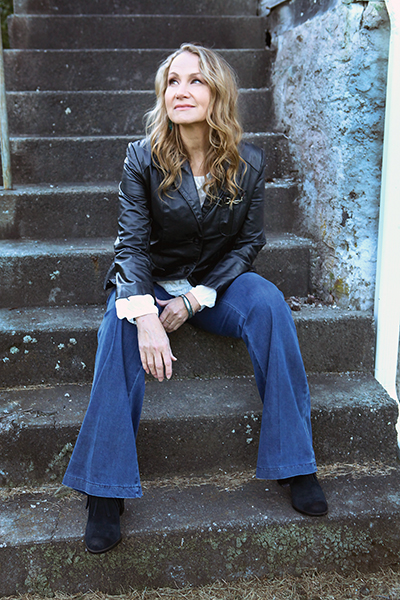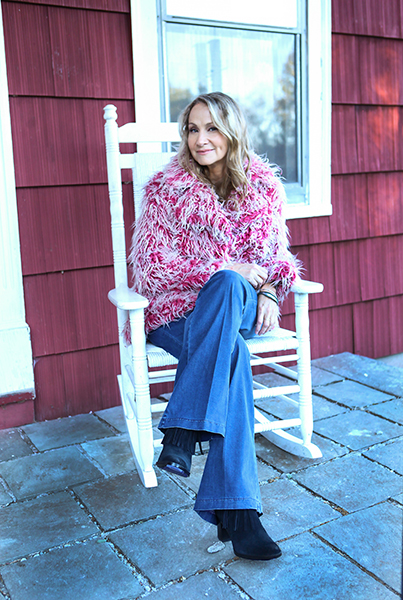Grammy Award-nominated singer/songwriter Joan Osborne has a flair for singular interpretations of other people’s songs and for making them her own.
Her 1995 breakout single “One of Us,” written by Eric Bazilian, is still in rotation to this day. On her new album, “Songs of Bob Dylan” (Womanly Hips), Osborne turns her attention to the music legend, now in his sixth decade as a recording artist. Osborne’s renditions of Dylan tunes, familiar (“Tangled Up In Blue” and “You’re Gonna Make Me Lonesome When You Go”) and lesser known (“You Ain’t Goin’ Nowhere” and “Dark Eyes”), are treated with the utmost reverence and worthy of repeated listens.
We talked with her about her Dylan tribute prior to her visit to the Tarrytown Music Hall:
Do you remember how old you were when you heard your first Bob Dylan song and what that song was?
“Dylan is so pervasive, and in particular in the 1960s. I was born in the early ’60s (in Anchorage, Kentucky), so I probably heard a nun playing ‘Blowin’ in the Wind’ at a guitar Mass or something. It’s one of those things where you just always knew about him. I’ve forgotten when I first learned about him or heard about his music.”

You covered Dylan’s “Man in the Long Black Coat” on your 1995 breakthrough album “Relish.” Was the concept for your new album “Songs of Bob Dylan” percolating since then?
“It’s actually been percolating since I got this collection, ‘The Songbook Series,’ that Ella Fitzgerald put out in the 1950s and early 1960s. I believe it’s eight or nine records and each record was devoted to a different songwriter or songwriting team. In her era, it was Duke Ellington or Cole Porter or Harold Arlen. I always thought that was such a great idea.
“I had it in the back of my mind that I would like to put my own twist on that idea. I’m not a torch singer, per se, so I’m not going to cover a bunch of Cole Porter songs. The writers I’m drawn to are the giants of the contemporary era. I thought it was an interesting lens to look through by covering other people’s work. That idea has been percolating in my mind for quite a long time.
“Recently, we had the opportunity to do some residencies at the Café Carlyle in Manhattan. It seemed like the perfect place to test out this idea. The room itself has a long history of great cabaret singers. I’m not really a cabaret singer, but I thought maybe this would be the ideal opportunity to see if this songbook idea works. We tried it and people seemed to like it, to appreciate it and understand it.”
With so much material from which to choose, what was involved in the selection process of the 13 tunes on “Songs of Bob Dylan”?
“As you might imagine, that was one of the difficulties — to narrow down this massive amount of songs and body of work into just one record. I certainly could make another 10 records and still not run out of great Bob Dylan material. I did have a few criteria. First, I wanted to make sure that we picked material from throughout his career. As you mentioned, I put a song from the ‘Oh Mercy’ record on my first major-record release. ‘Oh Mercy,’ from the 1980s, is one of my favorite Dylan albums, but not one of his best-known ones.
“We also picked a song from 2001’s ‘Love and Theft’ to represent late-period Dylan. We wanted to include his classic ’60s and ’70s period as well as the ’80s, ’90s and ’00s, to mix it up in that way. I also wanted to have songs that people were familiar with, such as ‘Tangled Up In Blue’ or ‘Highway 61 Revisited,’ that even the most casual Dylan fan is likely to know, and then go for deeper cuts such as ‘Dark Eyes’ from ‘Empire Burlesque.’ I didn’t even know about that song until Patti Smith told me about it.”
Among other things, Dylan is revered for the lyrics to his songs. Are there songs of his with lyrics that have particular resonance to you?
“In the last couple of years, some of the songs that he wrote in the 1960s have become increasingly relevant as we’re facing a situation in the country that, in a way, mirrors that time. So much upheaval, so much violence, so much division in our society. I think the work he did in that time and, particularly the stuff that was more overtly political, is incredibly relevant to me and to everybody else who’s thinking about these things right now.”
You do a marvelous rendition of “Buckets of Rain,” which made me think about Bette Midler’s cover on her “Songs for the New Depression” album on which she was joined by Dylan. If you could have performed a duet with Dylan on one of the songs on the album, which one would you choose?
“Wow, that’s a really good question. We actually did a duet years ago on his song ‘Chimes of Freedom.’ But I don’t think I would pick that. Maybe ‘Shooting Star,’ which is also from ‘Oh Mercy.’ A beautiful song, a wistful ballad looking back at a relationship in the past, expressing tender sentiments to that person. You get the feeling that it wasn’t an easy relationship and that it might have broken up over conflict. But he’s looking back and telling that person how much he admired them. I think it’s such a generous and beautiful song.”

As a songwriter, you have a reputation for covering other people’s songs, including Gary Wright’s “Love Is Alive,” Stevie Wonder’s “Love’s in Need of Love Today” and Hall and Oates’ “Sara Smile” as examples. Have you ever heard a cover of one of your songs that you enjoyed, and if so, what was the song and who was singing it?
“‘One of Us’ gets covered a lot. Every so often I’ll get an email or text message from one of my nieces saying that someone did the song on ‘America’s Got Talent’ or ‘The Voice’ or even some of the more far-flung ones like ‘Indonesia’s Got Talent’ or ‘South Africa’s Got Talent.’ I’ve heard a lot of versions of the song done in beautiful ways and that’s gratifying.
“Even though I didn’t write the song, I had the first version of it, and my version was fairly successful. So I feel like it’s a wonderful thing to see other people taking up the mantle and using that song for what they want to use it for. There’s a certain classic element to the song. It’s not telling anybody what they’re supposed to think. It’s asking them to search their own hearts and minds. There’s always room for that, in art or music, to allow people to search their own heart, to say, ‘What are you thinking or feeling about this?’ I think it’s unusual for a pop song to send you in that way.”
You are performing at Tarrytown Music Hall. As someone who has spent a number of years in New York, do you have favorite spots that you frequent in Westchester County?
“Some of the river towns are beautiful. I love going up to Tarrytown. On the day of a show we’ll try to get there early and walk those steep roads and streets next to the river. It’s almost like going for a hike, but through a beautiful little town. I like those small towns which have, of course, become suburbs of New York City and the train lines have expanded. Yet they still have this small-town, old-school feel that I really like.”
Joan Osborne performs Feb. 8 and 9 at the Tarrytown Music Hall. For more, visit tarrytownmusichall.org.



